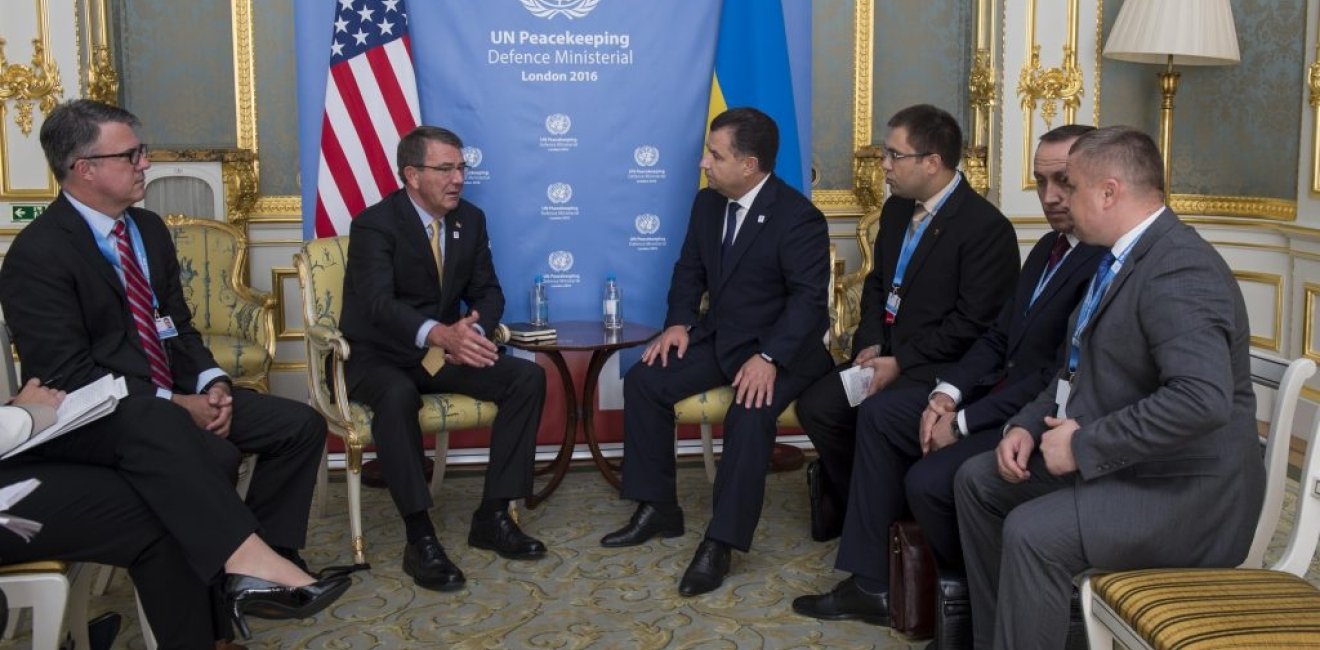
A blog of the Kennan Institute
BY VASYL FILIPCHUK
Russia’s proposal to have a UN peacekeeping operation on the contact line in eastern Ukraine has accelerated the international negotiating process regarding settling the conflict in the Donbas. The use of peacekeepers has already been discussed at recent meetings in Belgrade between the newly appointed U.S. special envoy, Kurt Volker, and Russian presidential aide Vladislav Surkov. Ukrainian political circles and the public have also been intensely discussing the possibility of UN peacekeepers in this war-torn region.
There is little understanding yet what the peacekeepers’ mandate might be. In early September Vladimir Putin proposed that armed peacekeepers be deployed along the line of contact between Ukrainian troops and the separatist forces and that their task should be one of ensuring the security of the OSCE unarmed monitors. According to the Kremlin’s vision, the functions of the UN peacekeeping mission in eastern Ukraine would be more of the monitoring kind than of a peace-enforcing mission, which means the peacekeeping forces would be limited in their use of force. As a result, they would be unable to stop the fighting. Such a limited mandate might be of little use. For instance, the United Nations Supervision Mission in Syria was deployed in April 2012 under a UN Security Council resolution, but its activities were suspended four months later as the military monitors could do little or nothing to stop the violence.
There is a way, however, that the deployment of UN military personnel could make a real contribution to establishing a lasting cease-fire or even to resolution of the conflict in eastern Ukraine if their mandate is broadened to include administrative and civilian functions.
Usually peacekeepers are able to use force to protect their lives and their principal mandate, which is to disengage hostile troops and military hardware. In particular, first-generation peacekeeping missions mostly have a short-term purpose, namely, to stop violence. Thus deployment of peacekeeping forces to the Donbas could be a means of “freezing” the conflict even as the situation in the region remained a source of confrontation. In addition, areas not controlled by the Ukrainian government would continue to be a “gray zone,” beyond Ukraine’s jurisdiction or the reach of the UN mission.
Owing to the limited purpose and expected results of a first-generation mission, it seems clear that Ukraine needs a second-generation peace operation in the Donbas. In addition to disengagement of troops along the line of contact, such a UN mission could also include police and civilian personnel capable of exercising transitional administration over the entire non-government-controlled areas, pursuant to the UNSC mandate. Depending on the UNSC mandate, an international interim administration may have a variety of functions, from demilitarizing combatants and restoring public order to facilitating local elections and economic recovery. For instance, with the aid of the United Nations Transitional Administration for Eastern Slavonia, Baranja and Western Sirmium, a UN mission with a broad mandate, Croatia managed to peacefully restore sovereignty over non-government-controlled regions.
If such a concept of the UN mission is agreed to, an international interim administration could make a significant contribution to stabilizing the situation in eastern Ukraine in several ways.
First, activating the military component of an international interim administration could lead to a cessation of the fighting. This would save thousands of lives in the Donbas, both civilian and combatant lives.
Second, an international interim administration may help to significantly reduce transnational threats arising from the gray zone in the Donbas, such as illegal arms trafficking, drug trafficking, smuggling, and the like.
Third, an international interim administration, if broadly mandated, could alleviate the oppression of local residents by the self-proclaimed republics. Thus the deployment of international civilian personnel could generally improve the human rights situation in Donbas. Moreover, an interim justice in the Donbas would likely dispel the fears of local residents of possible retaliation by Ukrainian authorities once Ukraine’s sovereignty over these areas is restored.
Fourth, agreeing to an international interim administration could be a face-saving option for Russia, which faces further economic sanctions, political pressure, and tarnishing of its reputation in the international arena.
Among all the possible options on the table, an international interim administration seems to be the most efficient and feasible means for the peaceful restoration of Ukraine’s sovereignty over non-government-controlled areas. Therefore the time is ripe for diplomats, politicians, and experts to raise the possibility of an international interim administration in the Donbas with the goal of achieving comprehensive conflict resolution rather than a lasting cease-fire.
Author


Kennan Institute
After more than 50 years as a vital part of the Wilson Center legacy, the Kennan Institute has become an independent think tank. You can find the current website for the Kennan Institute at kennaninstitute.org. Please look for future announcements about partnership activities between the Wilson Center and the Kennan Institute at Wilson Center Press Room. The Kennan Institute is the premier US center for advanced research on Eurasia and the oldest and largest regional program at the Woodrow Wilson International Center for Scholars. The Kennan Institute is committed to improving American understanding of Russia, Ukraine, Central Asia, the South Caucasus, and the surrounding region through research and exchange. Read more

Explore More in Focus Ukraine
Browse Focus Ukraine
Talking to the Dead to Heal the Living

Ukrainian Issue in Polish Elections


